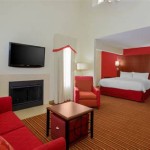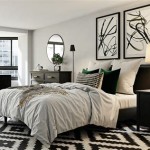Best Ways to Cool an Upstairs Bedroom
Maintaining a comfortable temperature in an upstairs bedroom, particularly during warmer months, can be a persistent challenge for many homeowners. Heat rises, leading to warmer temperatures on upper floors, often resulting in discomfort and disrupted sleep. Implementing effective cooling strategies can significantly improve the living environment and promote better rest. This article explores various techniques and solutions to effectively cool an upstairs bedroom, addressing the underlying factors that contribute to the issue.
Understanding the Problem: Why Upstairs Bedrooms Get Hotter
The primary reason upstairs bedrooms tend to be warmer is due to the natural phenomenon of convection. Warm air is less dense than cool air and rises. This means that heat generated within the home, whether from appliances, electronics, or even occupants, will naturally accumulate on the upper floors. Furthermore, the roof absorbs sunlight and radiates heat downwards, directly impacting the rooms below, especially those without adequate insulation.
Additionally, factors such as window placement and orientation play a crucial role. Windows facing south or west receive more direct sunlight throughout the day, leading to increased heat gain. The material of the roof and siding also affects how much heat is absorbed and transferred into the home. Homes with dark-colored roofs, for example, will typically absorb more heat than those with lighter-colored roofs.
Inadequate insulation is a major contributor as well. Insulation acts as a barrier, preventing heat from flowing into the house during the summer and escaping during the winter. If the attic or the walls of the upstairs bedroom are not properly insulated, heat can easily penetrate the living space.
Effective Cooling Strategies: A Multifaceted Approach
Addressing the issue of a hot upstairs bedroom requires a comprehensive strategy that tackles the various contributing factors. This involves a combination of improving insulation, managing sunlight exposure, enhancing ventilation, and utilizing cooling appliances.
Improving Insulation: This is arguably the most impactful long-term solution. Focus on insulating the attic, walls, and floors of the upstairs bedroom. The attic is a prime location for heat gain, so ensuring it has adequate insulation can significantly reduce the temperature in the rooms below. Consider using materials with a high R-value, which indicates the insulation's resistance to heat flow. Common insulation materials include fiberglass batt insulation, cellulose insulation, and spray foam insulation. Spray foam offers excellent insulation and also seals air leaks, providing an additional benefit.
Walls, particularly exterior walls, should also be properly insulated. If the walls are already insulated, consider adding more insulation to increase the R-value. This can be done by blowing insulation into the wall cavities. Furthermore, insulating the floor between the upstairs bedroom and the room below can help prevent heat from rising into the bedroom.
Managing Sunlight Exposure: Controlling the amount of sunlight that enters the upstairs bedroom is crucial. Implement strategies to block or reflect sunlight before it has a chance to heat the room. Window treatments play a significant role in this regard. Blackout curtains are highly effective at blocking sunlight and preventing heat from entering the room. These curtains are made with a special lining that prevents light from passing through.
Another option is to use reflective window film. This film is applied to the windows and reflects a significant portion of the sunlight that hits them. This can significantly reduce the amount of heat that enters the room. Exterior shades or awnings can also be used to block sunlight before it reaches the windows. These are particularly effective for windows facing south or west.
Planting trees or shrubs around the house can also provide shade and help cool the upstairs bedroom. Deciduous trees are particularly useful because they provide shade during the summer but lose their leaves in the winter, allowing sunlight to enter and warm the house.
Enhancing Ventilation: Proper ventilation helps to circulate air and remove hot air from the upstairs bedroom. This can be achieved through a variety of methods. Opening windows at night when the temperature is cooler allows cool air to enter the room and displace the hot air. However, it is important to close the windows during the day to prevent hot air from entering.
Using fans to circulate air is another effective strategy. Ceiling fans help to mix the air in the room and create a more even temperature. They also create a cooling effect by evaporating perspiration from the skin. Box fans can be placed in windows to draw cool air in from outside or to exhaust hot air from the room. Whole-house fans are installed in the attic and can exhaust hot air from the entire house, drawing cool air in through open windows. These are particularly effective in climates with cool nights.
Consider using an attic fan to exhaust hot air from the attic. This can significantly reduce the temperature in the rooms below. Attic fans can be thermostatically controlled, so they only run when the attic temperature reaches a certain level.
Utilizing Cooling Appliances: Targeted Temperature Control
While insulation, sunlight management, and ventilation are crucial, cooling appliances provide targeted temperature control for immediate relief. The appropriate appliance depends on the size of the room, personal preferences, and budget.
Air Conditioners: Air conditioners are the most effective way to cool an upstairs bedroom. There are several types of air conditioners to choose from, including window air conditioners, portable air conditioners, and central air conditioning systems. Window air conditioners are the most common type and are relatively inexpensive and easy to install. However, they can be noisy and block the window. Portable air conditioners are also relatively inexpensive and can be moved from room to room. However, they require venting to the outside, typically through a window. Central air conditioning systems are the most effective way to cool an entire house, but they are also the most expensive to install and operate.
When choosing an air conditioner, it is important to consider the size of the room. Air conditioners are rated in British Thermal Units (BTUs), which measures their cooling capacity. A larger room will require an air conditioner with a higher BTU rating. It is also important to consider the energy efficiency of the air conditioner. Look for air conditioners with a high Energy Efficiency Ratio (EER) or Seasonal Energy Efficiency Ratio (SEER). These ratings indicate how efficiently the air conditioner uses energy.
Evaporative Coolers: Also known as swamp coolers, these devices cool air through the evaporation of water. They are most effective in dry climates with low humidity. They draw in hot, dry air and pass it through a wet pad, which cools the air as the water evaporates. The cooled air is then circulated into the room. Evaporative coolers are generally less expensive to operate than air conditioners, but they are not as effective in humid climates.
Dehumidifiers: While not directly cooling devices, dehumidifiers can indirectly improve comfort by removing excess moisture from the air. High humidity can make the air feel hotter and more uncomfortable. By removing moisture, dehumidifiers can make the air feel cooler and more comfortable. They are particularly useful in humid climates or in rooms that are prone to moisture buildup. They work by drawing in air and passing it over a cold coil, which condenses the moisture. The condensed water is collected in a tank, and the dry air is exhausted back into the room.
Strategic Appliance Usage: Optimizing the use of appliances within the bedroom can contribute to a cooler environment. Limit the use of heat-generating appliances like incandescent light bulbs or electronics when possible. Opt for LED lighting, which produces significantly less heat. Unplug electronic devices when not in use, as they can still generate heat even when turned off. Avoid using the oven or stove during the hottest part of the day, as this can contribute to increased heat within the house.
Furthermore, consider adjusting the thermostat strategically. During the day, when the upstairs bedroom is unoccupied, raise the thermostat setting to conserve energy. Then, lower the thermostat setting a few hours before bedtime to pre-cool the room for optimal sleep conditions. Utilizing programmable thermostats can automate this process and ensure consistent temperature control.
Additional Considerations: Lifestyle Adjustments and Maintenance
Beyond implementing the strategies described above, lifestyle adjustments and regular maintenance can further enhance the effectiveness of cooling an upstairs bedroom.
Simple changes like choosing lightweight, breathable bedding can promote better airflow and prevent overheating during sleep. Cotton and linen are excellent choices. Staying hydrated throughout the day can also help regulate body temperature. Drinking plenty of water allows the body to cool itself through perspiration.
Regular maintenance of cooling appliances is essential for optimal performance. Clean or replace air conditioner filters regularly to ensure efficient airflow and prevent dust and allergens from circulating. Similarly, maintain evaporative coolers by cleaning the water reservoir and replacing the cooling pads as needed. Clean ceiling fan blades regularly to remove dust and ensure optimal airflow.
Finally, consider consulting with a professional HVAC technician. They can assess the specific challenges in your home and recommend tailored solutions. They can also perform energy audits to identify areas where energy efficiency can be improved. A professional assessment can often uncover hidden issues, such as air leaks in ductwork, that are contributing to the problem.

Ac Not Cooling Upstairs Tips To Cool The Of Your Home

How To Keep Your Upstairs Cool During The Summer Wyckoff

Upstairs Bedroom With Sloped Ceilings

Modern Tips Moving The Living Room Upstairs Michael And Associates

Cooling Tips For Upstairs Bedrooms Gentry Air Conditioning

25 Charming Cape Cod Upstairs Bedroom Ideas To Inspire You

Gorgeous Attic Bedrooms That Will Make You Want To Move Upstairs

15 Attic Bedrooms That Will Make You Want To Clean Out Upstairs Asap

30 Dreamy Attic Rooms Sloped Ceiling Design Ideas

Five Ways To Keep Your Loft Conversion Cool This Summer








